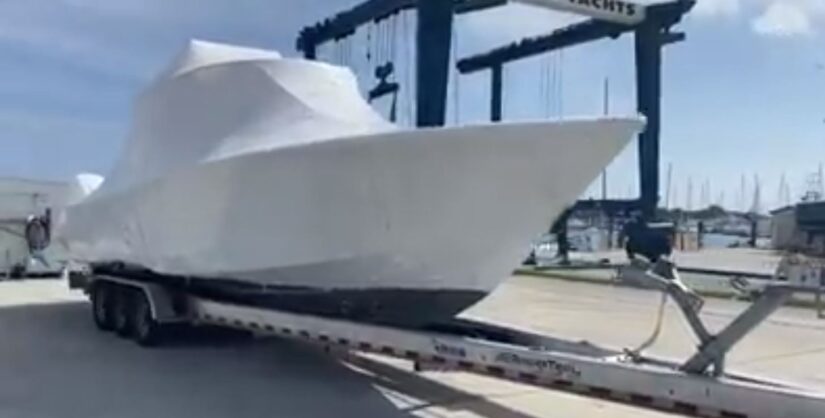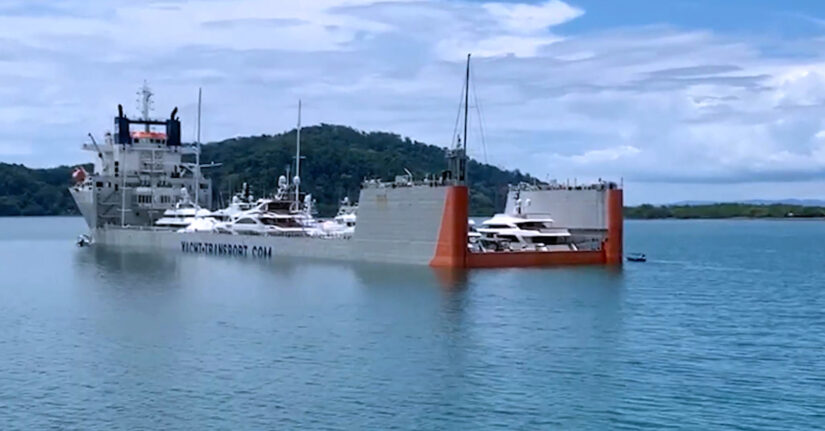Have you found the perfect yacht, only to realize it’s located in another state—or even another country? Don’t let geography stop you. Modern yacht transportation services make it easier than ever to move your yacht safely and securely to your desired destination. Whether by land, water, or shipping container, there’s a solution that fits your needs.
Below, we’ve outlined the main yacht transport options available today, along with tips to ensure a smooth and stress-free relocation. As always, your yacht broker or dealership is your best resource—they can connect you with trusted professionals who specialize in marine transport.
Disclaimer: This guide is for educational purposes and does not replace professional or legal advice.
Yacht Trucking (Land-Based Transport)
 Ideal for domestic moves within the U.S., yacht trucking involves transporting your boat overland using specialized trailers designed for oversized loads.
Ideal for domestic moves within the U.S., yacht trucking involves transporting your boat overland using specialized trailers designed for oversized loads.
Key Details:
- Best for: Boats under ~70 feet.
- Pricing depends on: Boat size, beam/height, destination, season, and permits.
Requirements:
- Transport permits for each state.
- Full insurance coverage (both by company and owner).
- Vessel prep for overland travel.
Tips:
- Confirm the company is fully licensed, insured, and experienced with yacht transport.
- Ask how the boat is protected from road damage, theft, or weather exposure.
Yacht Transport Ship (Overseas or Long-Haul)
 This method involves loading your yacht from the water onto a cargo ship. It’s commonly used for overseas transport and is not just for superyachts—many transporters accept boats in the 40–80 ft. range.
This method involves loading your yacht from the water onto a cargo ship. It’s commonly used for overseas transport and is not just for superyachts—many transporters accept boats in the 40–80 ft. range.
Key Details:
- Best for: International or transoceanic moves.
- Pricing varies based on: Size/weight, route, and logistics required.
- How it works: Lift-on/lift-off or float-on/load-on from the water to ship deck.
Tips:
- Always verify insurance coverage before booking.
- Understand the transport timeline, port options, and unloading procedures.
Container Shipment
For smaller boats, shipping via 40-foot freight containers is cost-effective and secure.
Key Details:
- Best for: Boats under 38 feet and beams less than 7’8″.
- Loading style: Side-loaded or straight-in, then secured and sealed.
- Benefits: Lower cost, good security, and faster processing.
Tips:
- Confirm how the boat will be loaded and request photos or documentation.
Delivery Captain (By Water)
 A delivery captain can move your yacht from port to port using its own engines. This is a great option for yachts that are water-ready and located within a few days’ range of your desired location.
A delivery captain can move your yacht from port to port using its own engines. This is a great option for yachts that are water-ready and located within a few days’ range of your desired location.
Key Details:
- Best for: Regional or coastal deliveries.
- Costs to consider: Captain’s fee, crew wages, fuel, provisions, and insurance.
Tips:
- Start sourcing a captain at least four weeks prior to closing.
- Make sure the captain is licensed and familiar with the intended route.
- Review your insurance policy for coverage of captained trips.
What Should Be in Your Delivery Contract?
A detailed contract protects both you and the captain. It should include:
- Departure and destination ports
- Delivery window and estimated time underway
- Required route or stopovers
- Captain and crew per diem
- Travel expenses and limits on repairs
- Dispute resolution terms
Work with your yacht broker to ensure all legal details are covered.
Pre-Transport Checklist
No matter the transportation method, preparation is key. Here’s a checklist to follow before hand-off:
- Remove all personal items and valuables.
- Secure or remove loose equipment, cushions, electronics, and canvas.
- Disconnect batteries and shut off fuel and water systems.
- Drain holding tanks (if required).
- Photograph and document the vessel’s condition.
- Review transport company requirements.
- Arrange marina haul-out, cradle prep, or crane service (if needed).
- Shrink-wrapping or winterizing your boat before any kind of loading transport is highly advised and will provide an extra layer of security while in transit.
International Yacht Transport Considerations
If you’re importing a yacht across borders:
- Hire a customs broker to assist with duties and paperwork.
- Be prepared to pay import taxes, tariffs, and EPA/USCG compliance fees (especially in the U.S.).
- Have all documentation ready: title, bill of sale, registration, and manufacturer compliance.
Timing: When to Schedule a Yacht Transport
- Transport should begin after the yacht sale is closed and ownership has legally transferred.
- Coordinate timelines with your marina, transport company, surveyor, and captain.
- Expect a lead time of 3 days to 3+ weeks for delivery depending on method and destination.
Seasonal & Environmental Considerations – Yacht Transportation
- Costs and delays can spike during hurricane season or peak summer months.
- Some routes may be affected by storms, freezing temperatures, or high seas.
- Transporting in off-peak seasons (spring/fall) can reduce both cost and congestion.
Tech Tip: Monitor Your Yacht During Transit
Consider adding a temporary GPS tracker or onboard monitoring system (like Siren Marine or Garmin). These allow you to:
- Track your yacht in real time.
- Receive notifications for movement, temperature, or battery status.
- Maintain peace of mind during long transports.
Final Thoughts – Yacht Transportation
With proper planning and support, moving your yacht after the sale can be an easy, worry-free process. Each transportation method has its pros and cons, but the right fit depends on your yacht’s size, your timeline, and your final destination.
Work closely with your yacht broker—they can connect you with trusted professionals, recommend the most efficient route, and help you protect your investment from the moment it changes hands.
You May Also Like:
First-Time Yacht Buyer Insurance Guide
Buying a New Yacht Checklist & Tips
Yacht Financing Options | Yacht Buyers Guide
Policies & Coverage | Yacht Insurance Guide



 Ideal for domestic moves within the U.S., yacht trucking involves transporting your boat overland using specialized trailers designed for oversized loads.
Ideal for domestic moves within the U.S., yacht trucking involves transporting your boat overland using specialized trailers designed for oversized loads. This method involves loading your yacht from the water onto a cargo ship. It’s commonly used for overseas transport and is not just for superyachts—many transporters accept boats in the 40–80 ft. range.
This method involves loading your yacht from the water onto a cargo ship. It’s commonly used for overseas transport and is not just for superyachts—many transporters accept boats in the 40–80 ft. range. A delivery captain can move your yacht from port to port using its own engines. This is a great option for yachts that are water-ready and located within a few days’ range of your desired location.
A delivery captain can move your yacht from port to port using its own engines. This is a great option for yachts that are water-ready and located within a few days’ range of your desired location.